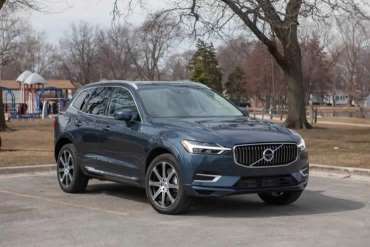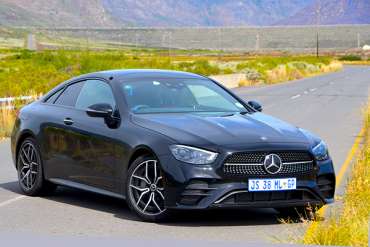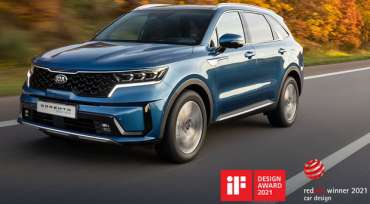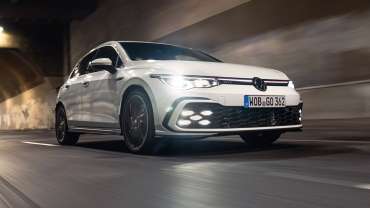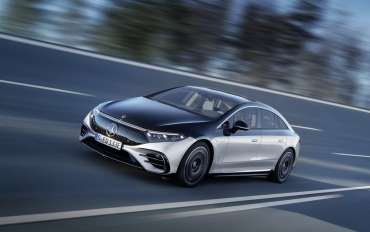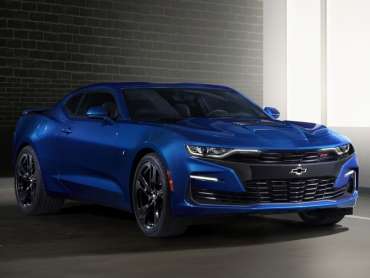
Worldcarblog.com
2021 Volvo XC60 Recharge Review: Plug-In Hybrid Pass/Fail
The verdict: Volvo’s five years of experience building plug-in-hybrid SUVs seems to be paying off, as the Recharge T8 version of the 2021 XC60 luxury compact SUV is as well rounded in its plug-in aspects as the gas version is in every other way.
Versus the competition: This will soon change, but the XC60 T8 has few direct competitors, though it matches the 2021 Audi Q5 e for electric range and gas mileage, and it trounces the 2021 BMW X3 xDrive30e in the latter category. For both metrics, the model to beat might be the Corsair Grand Touring, coming this spring from a resurgent Lincoln.
Volvo appears to be using the word “Recharge” to represent any vehicle with a plug, be it a pure battery-electric, such as the new XC40 Recharge subcompact SUV, or this plug-in hybrid version of the XC60 compact SUV. Perhaps a better indicator is the “T8” powertrain designation, which we’ve seen only on plug-in hybrids, including the larger XC90 Recharge T8. The original Volvo XC60 is an excellent luxury compact SUV, good enough to win our 2018 comparison test. Not much has changed — either for the XC60 or its competitors — since. Rather than rehash what we like about it, I’ll direct you to our most recent comprehensive review of the regular XC60 and focus here on the plug-in hybrid.
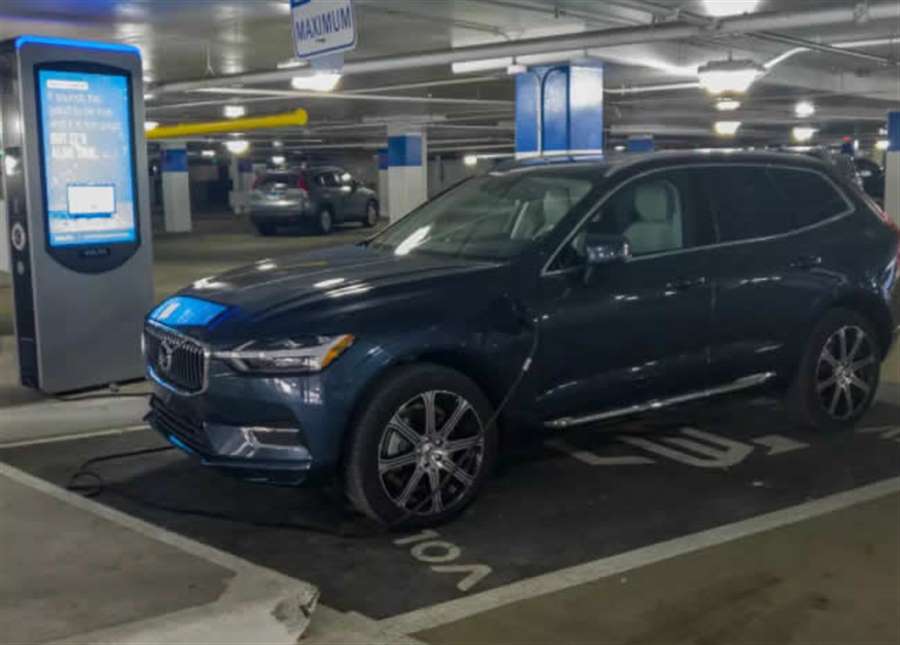
Ten years’ experience has revealed the many ways in which a plug-in hybrid electric vehicle, or PHEV, can go astray, so I’ve come to focus my evaluations of them on these factors. Each area undergoes a pass/fail test to determine whether the vehicle as a whole passes muster. Behold the XC60’s Recharge’s results:
Electric Range
This is an important one because early PHEVs had electric ranges that were comically short. One of the first, the 2012 Toyota Prius Plug-In Hybrid, could drive only 6 miles on electric power, as estimated by the EPA.
We’ve come a long way since then. Most PHEVs go roughly 20 miles before their gas engines are needed, and they can even achieve highway speeds gas-free. The Prius Plug-In’s successor has been succeeded by today’s vastly improved Prius Prime, which has a 25-mile electric range. The EPA estimates the XC60 T8 can go 18 miles on a charge. I matched or exceeded that number twice, thanks in part to favorable weather.
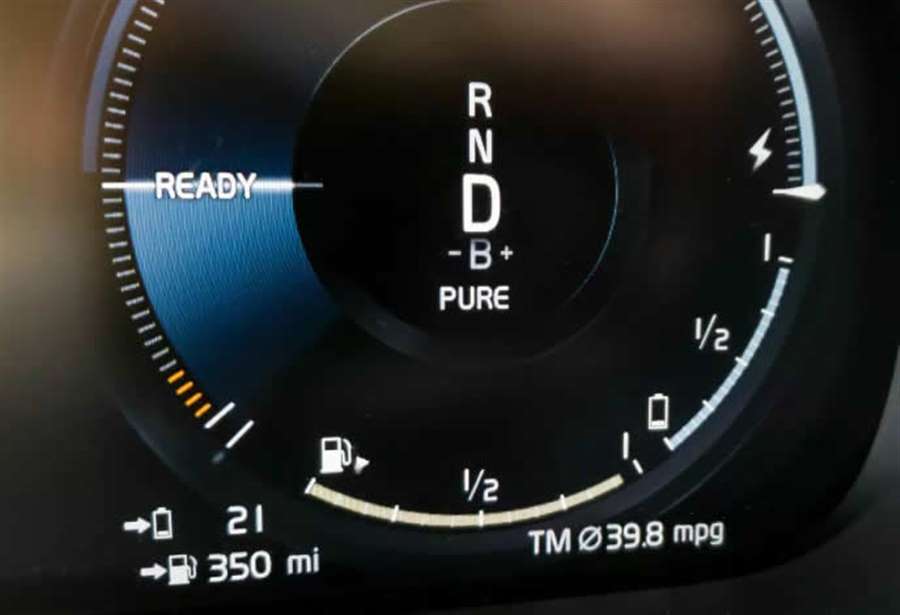
This test isn’t about whether the vehicle hits its estimate, though; it’s about the range itself, and anything under 20 miles feels too short. I know 18 miles is technically long enough — and I underscore that a 20-mile trip that uses gasoline for only 2 miles is still great — but the key word here is feels. American shoppers are driven by feeling as much as logic, if not more. (By the same token, 150 miles doesn’t feel like enough range for an all-electric car, even though it’s usually more than enough if you charge it nightly at home.) Also, cold temperatures invariably shorten range. So, bearing in mind that each of these pass/fail tests add up to an overall verdict, I’m going to consider any PHEV range under 20 a failure (or just a fail, as the kids say).
Pass/fail verdict: Fail
Electric Acceleration
In a plug-in hybrid, you want to have enough power to drive in electric-only mode without triggering the gas engine, at least under normal conditions. This is mainly a psychological thing given that it doesn’t hurt if the engine runs for a minute or two. It’s just the principle of it, you know? In its default, hybrid driving mode, the XC60 Recharge will accelerate under electric power at lower speeds, and you can maintain that so long as you keep the virtual needle on the gauge from crossing from the lightning symbol side of the tick mark (electric) to the droplet symbol side (gasoline). Note that while the needle moves with your acceleration, the tick mark and the threshold between electric and gas are also a moving target, depending on load, incline, etc.
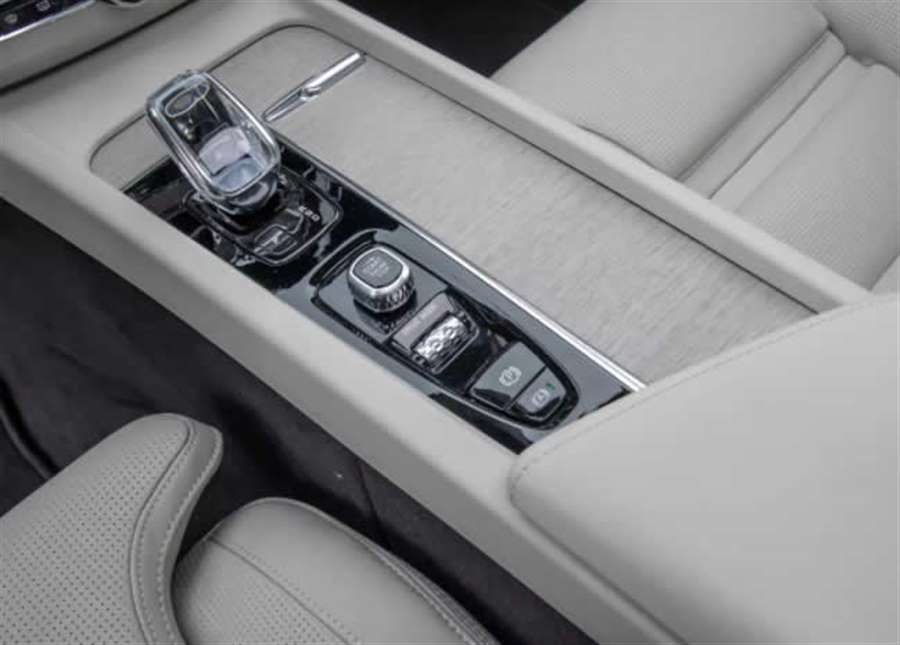
The true test of electric acceleration comes by locking a car in electric propulsion, which you do in the XC60 T8 by selecting the Pure driving mode; it’s available so long as there’s enough juice in your battery pack. In Pure mode, you can accelerate as hard as you want and stay in electric mode — so long as you don’t click the switch at the bottom of the accelerator pedal’s travel (it used to be called the kickdown switch). Power in the Volvo is modest because the goal in a PHEV isn’t to have a super-powerful electric motor and a super-powerful gas engine; that would be inefficient. The goal is for the motor and engine to be powerful together. If you’re in a bind and you floor it and click that switch, the gas engine comes to life and you get full acceleration. In normal driving, I found the Volvo’s electric mode to be adequate 95% of the time — but it bears noting that Cars.com is headquartered in the flatlands of Chicago.
I was able to achieve 70-plus mph on the highway, but one time after merging onto an interstate, I encountered a gentle uphill slope that climbed for at least a mile. With the T8 powertrain at the height of its electric abilities, I was below the speed limit and barely tacking on mph — with drivers behind me getting irritated and whipping around me. This was with only me in the car and no cargo weighing it down. Of course, in this instance, I could have easily floored the pedal the rest of the way and used the gas engine. If ever I had to pass, I’d definitely have needed to. If you drive in a hilly region, I suspect you’ll rely on the XC60’s gas engine more often than I did.
In my electric acceleration test, the XC60 T8 was borderline. It was certainly less effective on highways and hills, but because I like how it’s executed and it worked well where I drove it, I’ll give it a pass.
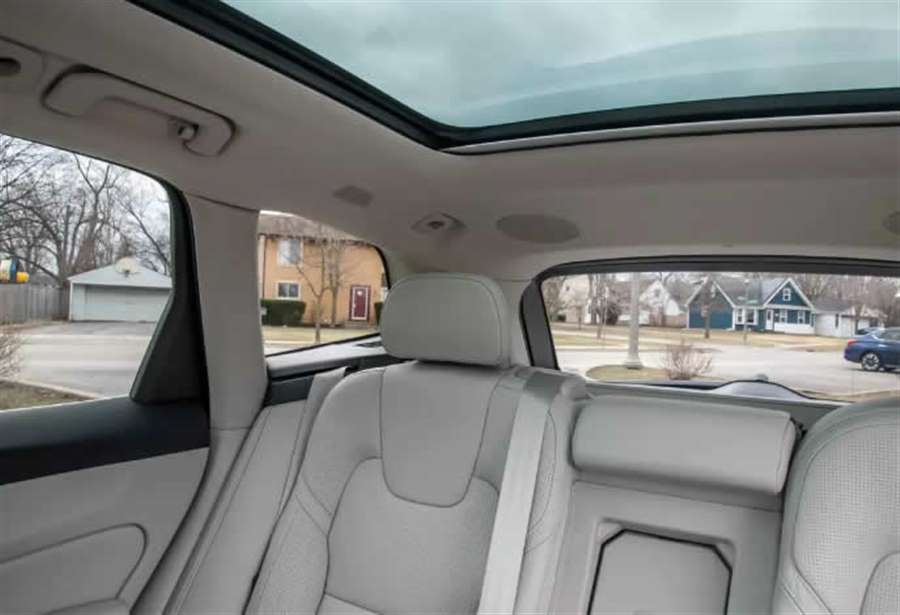
Pass/fail verdict: Pass
Hybrid Acceleration
Hybrid acceleration is also important, and it has different aspects. First, you don’t want to make sacrifices, and Volvo seems to know that. Its combination of the supercharged and turbocharged 2.0-liter four-cylinder engine with an electric motor provides 400 total system horsepower (415 hp in the Polestar Engineered trim level, thanks to different gas-engine tuning). These numbers are well above the most powerful non-hybrid XC60 — the T6’s 316 hp — but the hybrids also weigh considerably more, so it’s best to look at 0-60-mph times. According to Volvo, the T8 powertrain is the quickest to make that run, at 5.0 seconds (4.9 seconds in the Polestar Engineered). The T6 is rated at 5.6 seconds and the all-wheel-drive T5 at 6.4 seconds, so not only are you not losing acceleration by choosing the PHEV, you’re gaining it.
Then there’s how the acceleration feels. Hybrid powertrains have traditionally felt kinda herky-jerky, and that would definitely be a sacrifice in a luxury vehicle. Volvo has done a nice job with this one. It incorporates the same eight-speed automatic transmission as the non-hybrid T5 and T6, so you don’t get the droning and rubber-band effect earlier hybrid adopters suffered. It doesn’t feel 100% conventional, but it’s pretty close. The XC60 T8 passes the hybrid acceleration test.
Pass/fail verdict: Pass
Braking
That brings us to braking. Hybrid braking is often nonlinear and mushy-feeling — just generally not what you want. We’ve put up with it for the sake of better mileage, though, and fortunately hybrid braking action has been improving. Again, Volvo’s done a nice job here. I didn’t mistake the XC60 T8’s pedal feel for a conventional braking system, but some people might. It passes.
Pass/fail verdict: Pass
The Interior
If you don’t think the interior matters, you’ve probably never inspected a plug-in hybrid version of an existing vehicle before. Historically, squeezing a second propulsion system into a vehicle that wasn’t designed for it has meant something had to give. Battery packs in particular tended to diminish interior space, robbing either backseat legroom or cargo volume.
The XC60 T8 passes the cabin test with flying colors. Its seating dimensions are exactly the same as the gas-only versions of the XC60 front and rear.
Pass/fail verdict: Pass
Cargo Space
While we’ve seen some PHEVs whose floors are elevated to accommodate a battery pack, that’s not exactly the case here — though there is something weird going on because it isn’t perfectly level, which I don’t recall from the non-hybrid. It’s barely noticeable, though, and the cargo dimensions are once again the same between the regular and the Recharge versions of the XC60. The main sacrifice — visible if you raise the floor — is the lack of a spare tire. Instead, you get a compressor and some sealant goo. Honestly, there are a lot of vehicles nowadays that lack a spare tire with less of an excuse than the XC60 Recharge, so I’m not going to hold this against it.
Pass/fail verdict: Pass
Towing Capacity
Some hybrids just can’t hack towing, but the Recharge is rated to tow 3,500 pounds just like other XC60s. You can get an SUV that tows a considerably heavier trailer than the XC60, but when it comes to PHEV versus gas-only, the Recharge T8 passes the towing test.
Pass/fail verdict: Pass
Gas Mileage
Gas mileage is a crucial consideration, even if the vehicle has a long electric range but especially if it doesn’t. For the Volvo, there’s good news here: Once its electric charge is depleted, the XC60 Recharge is rated 26/28/27 mpg city/highway/combined on required premium gas. The XC60 T6 that’s closest to the Recharge’s performance is rated 23 mpg combined. Even the most efficient XC60 T5 with FWD is rated 25 mpg combined — 2 mpg less than the T8. That means you could buy a Recharge and never plug it in and you’d still get better mileage. While that would be a pointless waste, and I hesitate to give anyone bad ideas, any PHEV with better combined mpg than the rest of its range even without plugging in gets an automatic pass in the gas mileage test.
Pass/fail verdict: Pass
Overall Range
Another test inspired by PHEV history, this one is necessary because, while it’s pretty easy to see good electric range figures and mpg ratings, overall range is easily overlooked. When an automaker shrinks the gas tank significantly in order to make room for batteries, for example, the overall range can end up being pathetic. Not to fear: According to EPA estimates, the XC60 T8’s total range is 520 miles, 502 on gasoline. This beats the T5 FWD by 32-50 miles. The T8 passes the overall range test.
Pass/fail verdict: Pass
Price
The price test takes into account all the other tests. If a vehicle fails many of the previous tests, any price premium would be harder to swallow — and, conversely, if a vehicle had leading electric range or some other stand-out attribute, a higher price could be justified.
Because there’s a federal tax credit of over $5,400 for the Recharge, its price ends up being roughly $500 more than a comparable trim level with the T6 powertrain — the most powerful non-hybrid XC60. You can pay several thousand dollars less for a T5, but, as we’ve covered, it will be both less powerful and less efficient. Some $500 seems a small price to pay for a plug-in hybrid of the XC60 T8’s capabilities. At least so long as the tax credit remains available, it passes this test, as well.
The downside to tax credits is you have to pay more up front and won’t get the money back until the IRS sends your tax returns the following calendar year. The XC60 Recharge T8 starts with the Inscription Expression trim level with standard all-wheel drive at $54,595 (all prices exclude the incentive but include destination charges). It also comes in R-Design and Inscription trims before topping out with the Polestar at $70,595. Our test vehicle was an XC60 Recharge T8 Inscription with a base price of $61,000 but a total sticker of $71,340, including many options such as the Climate Package, Advanced Package, 4-Corner Air Suspension, Bowers & Wilkins premium audio and more.
Pass/fail verdict: Pass
Final Test Results
It shouldn’t surprise you that the 2021 Volvo XC60 Recharge T8 passes the overall plug-in hybrid test with flying colors. Honestly, I’d happily trade some of its horsepower and acceleration for more electric range, but it isn’t that simple when you’re combining electric motors with gasoline engines in existing models; automakers typically work with platforms that weren’t designed for hybrid use (though this is slowly changing), and they only have so many engines of their own to choose from. Given how many challenges and trade-offs manufacturers face, and the results we’ve seen in other PHEVs, Volvo has balanced things out quite nicely here. Five years of experience building plug-in hybrid SUVs is evident in the 2021 XC60 Recharge T8.
Madness called Porsche 911
But really crazy. And absolutely.
You don't believe it?
Take a look at the text…
Singer Vehicle Design… Magnus Walker… Kaege… Rauh Welt Begriff (or RWB)
These are all companies that base their games and games on a single car. The legendary "elfer" or more simply, the Porsche 911.
It is therefore worth concluding that fans of this legendary model from Zuffenhausen will never be short of choice - especially if they have deep pockets and thick wallets.
But all of the above "resto-moderi" have one minor problem: they have nothing to do with Formula 1. At least not directly. And that is why this text is a car that, according to everything, in a series of a total of 11 copies should overshadow all the above companies and their works.
Yes really.
For those of a slightly older production date, for whom Porsche is not just a mere adoration of technology and design stubbornness, Formula 1 will be a completely natural link to this famous brand. The same goes for driving legends made up of Niki Lauda, Alain Prost, Keke Rosberg, Steve Nichols and John Barnard as the constructors and Ron Dennis in the form of the eternal boss whose red and white cars practically destroyed the competition on tracks around the world within the craziest octane circus on the world.
And thus Marlboro as the main sponsor, and McLaren and Tag as the signatories of the car and engine technology form the second part of the legend of MP4 / 2 and MP4 / 3, ie the legendary cars from the famous and interesting history of Formula 1.
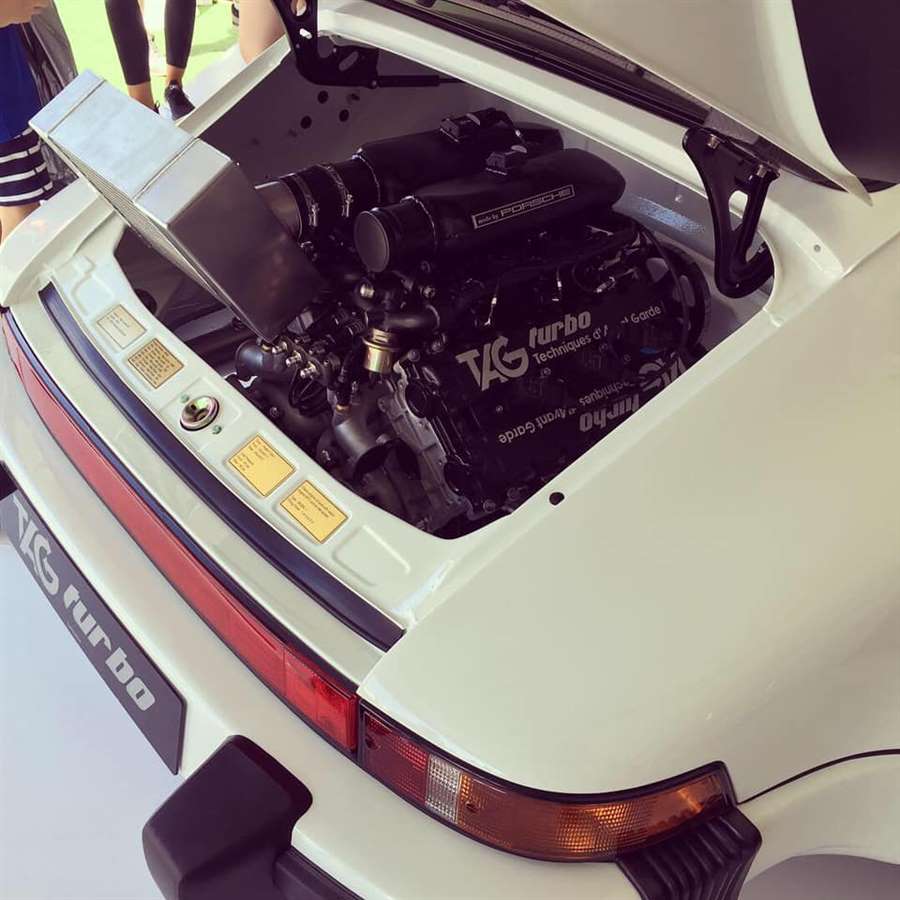
Do you see in which direction this story is going?
Basically, when McLaren is mentioned in public, the link to Porsche is not lacking. Because in the world of Formula 1, it was these two names that turned out to be Siamese twins. Admittedly, today McLaren and Porsche stand on diametrically opposite sides of the car world and make each other a competition, but that doesn’t matter now.
What it is, however, is the third company to decide to merge myth and legend in real time.
The company is called Lanzante and has been associated with McLaren in one way or another (read: in the real world and as part of the one that involves racing) for decades.
The myth is called the Porsche 911 Turbo, and the legend is still in its infancy, although it has been present for many years.
To elaborate…
Sometime in the mid-1980s, a disturbed team in a Porsche came up with the idea to install a real engine from the then Formula 1 car in a "simple" 930 Turbo.
It is a V6 engine with only 1.5 liters of volume, which in its qualifying edition far exceeded the figure of 1,000 horsepower.
akle, it really was a real engine that was jointly signed by Porsche and TAG, and with which Niki Lauda, Alain Prost and a few other F1-legends broke lap records wherever they appeared.
For many years this 930 Turbo was just a rumor. A story with which fans of the Porsche surname scared Ferrari lovers. An urban legend like Babaroga, Babadooka or that little shaggy one who comes out of the well every now and then and kills Japanese VHS hipsters. But a few years ago, this Porsche confirmed the legend in reality within the showrooms of McLaren's surgical clinic in Woking. And surprisingly, from then until today, there have been no violent reactions to this mobile disease.
… And so on until today, when this Porsche "Widowmaker" from McLaren gets permission to kill, and from the company Lanzante and the possibility of moving from the domain of epic songs to the reality that surrounds us. Because Lanzante plans to shove the TAG-Porsche_F1-monstrous under its tail and produce a total of 11 copies of this "elf" with the God complex.
By all accounts, the car world could soon get one of the most recognizable models of all time combined with one of the sickest engines of all time. And with that, the already iconographic Porsche 930 Turbo could truly become the most special Porsche car of all time.
By doing so, greats and geniuses from RWB, Singer and others could fall into the shadows. Because given the 1,000+ horses and the screaming of tiny pistons from the V6 engine at as much as 9,000 rpm, it wouldn’t be wrong to conclude that sicker than this just doesn’t go.
So even though no one has a clue about the actual performance of this weird white monster at the moment, it doesn’t really matter that much. Because nowadays to produce something like that is a display of a kind of madness.
It is sociologically incorrect. Politically as well, and not to mention ecology and similar branches that people emphasize. And that's why this Porsche 911 Turbo is simply a white whale, ie a mythical animal sung as part of literary works, and one of those oversized organisms that many still fear today, but it is still more people appreciate.
And we already adore him because of his very existence!
2021 Mercedes-Benz E 300 Coupe AMG Line Review
Only launched a few weeks back, we have already had the chance to test Mercedes-Benz’ all-new E-Class Coupé. In fact, this E300 Coupé was a bit like Darth Vader’s wheels. Well, that’s what at least two of the people we happened across said. They’re coupled at the tote, old Darth Vader and black.
Anywa, this is the freshly face lifted Mercedes-Benz E 300 Coupe AMG Line. And it does one thing really well. It very much looks the part. But it also does a so much else very well, too.
E 300 Coupé Accelerates Strongly, Handles Well
Acceleration is impressive, smooth; road holding and handling involving – especially at an elevated pace. For a larger family-coupé, that is. Albeit a touch rowdy, this latest 255 hp 277 lb-ft Nm turbo four-pot has a fruity exhaust note and works the chassis well enough. Although that four-cylinder noise may be a disappointment to the petrol heads expecting a V8 burble. Welcome to tomorrow, Darth Vader.
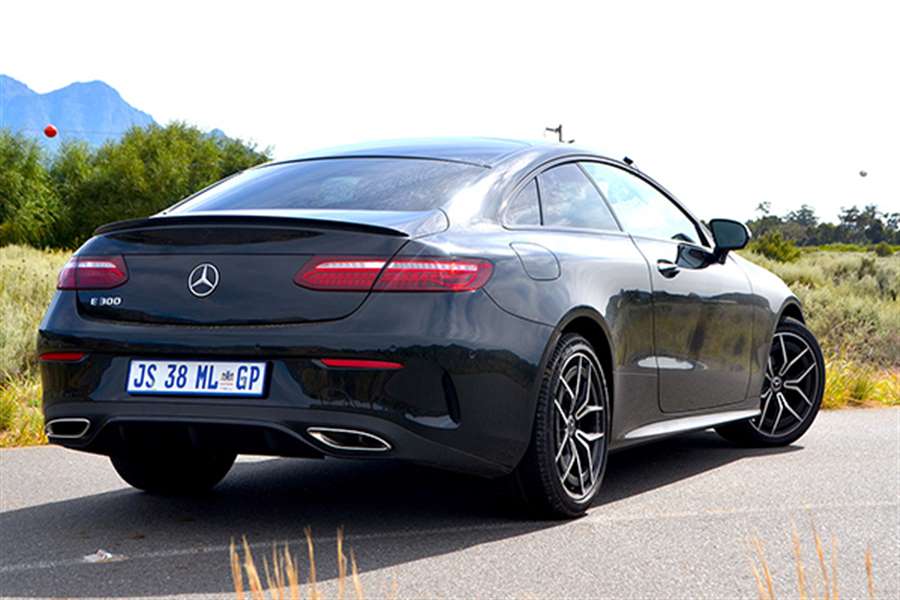
Tight, fast cornering is a pleasure and road-feel is positive, if a tad noisy over rougher tar surfaces. Probably because of those tires. Otherwise, it’s silent as a ghost with impeccable ride quality. The E 300 Coupé reduces the effects of gnarly speed-reducing road-bumps and humps to a far smoother, more acceptable experience.
That 9-speed gearbox is a treat in everyday driving, although it tends to get a bit laggy if you push it hard, when the car’s considerable heft also starts to make itself known. And we noticed a tendency to creep without notice when stopped and idling though.
But there’s more to this car than just the go. It has the show in spades, too. Ours had the coolest black on black wheels and LED headlights on the outside. And if technology exists, it’s in this AMG line specced cabin.
E300 Coupé Party Time as tech Meets Craftsmanship
Our specimen E300 Coupé had an impressive and immaculate party time red and black trimmed leather cabin. Red? Oh dear – don’t tell old Darth. It’s an intriguing space where Mercedes tech meets craftsmanship. Unique turbine vents compete with that twin 12.3-inch widescreen in a spectacular trade-off for the most attention.
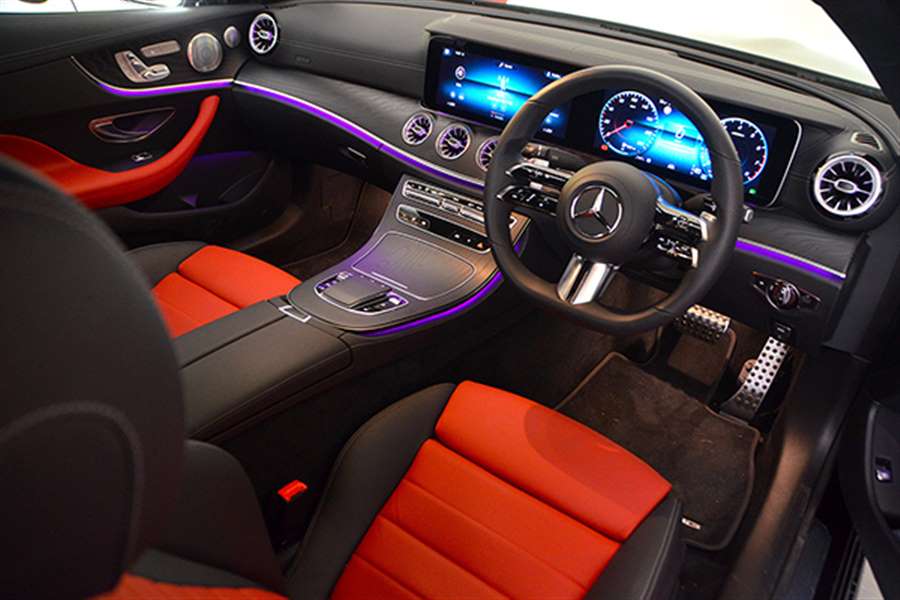
Mercedes-Benz has also taken its already hugely impressive multifunction steering wheel tech another step forward. It takes a bit of getting used to, but the expanded touch tech on this new wheel takes multifunction to a new level altogether. Merc’s rivals were still trying to catch up to the touchpad tech on the last level multifunction wheel. Now it’s just moved even further ahead…
You get a kaleidoscope of ambient lighting, a reversing camera, split folding rear seats and that bigger 12.3-inch screen. Trying hard to be an IMAX cinema on wheels, with proper smartphone connectivity to boot, infotainment really is top class. And Miss My Mercedes at your beck and call.
It’s Roomy for a Merc Coupé
The seats are adjustable. In every direction. So, in spite of a lower driving position visibility is great. Add a panoramic roof and splendid 13-speaker Burmester stereo. And even a Driving Assistance pack for semi-autonomous motorway driving. It had a Lane Tracking pack, which I’d never have. I stopped to turn it off post haste. But if that floats your boat…
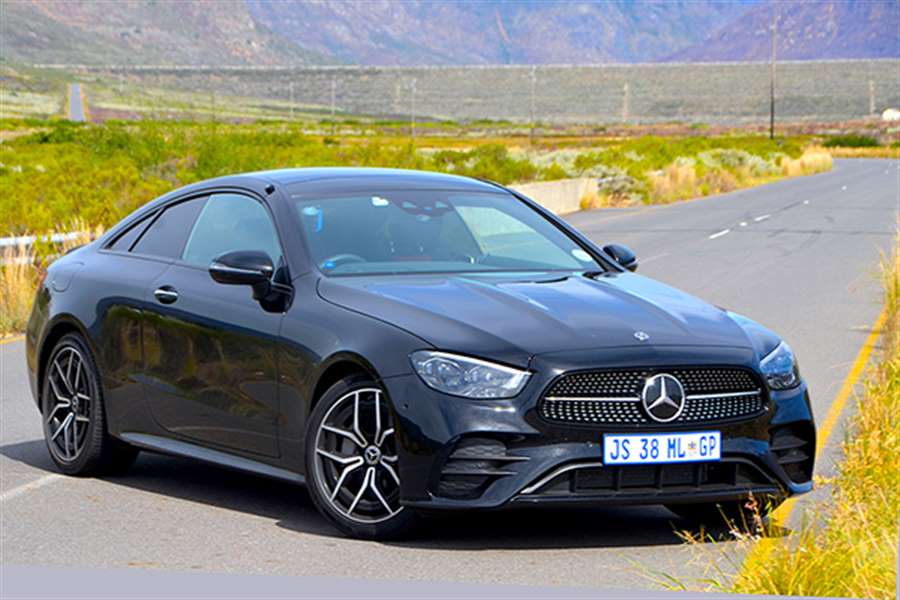
That cabin really looks great and has high quality, rigid components. Typical merc. Most of all, this E 300 Coupé is sensibly roomy and without much compromise. Which is good for a Merc coupé. Four adults fit inside. All their baggage in the cavernous trunk. And those pillarless windows bring a bit of Subaru-esque je ne sais quoi, mind you.
So, if looking good and driving cool is high on your agenda, this Vader-like E-Class Coupe defines Mercedes at its imperious best. Not quite the boy racer, it’s more of a sporty posh luxury sled. It away takes that driving stress, rather than piling it on.
E300 Coupé is basically a Mini Me S Coupé
And it’s half the price of its S-Class Coupe big bro, so maybe best without the badge. It is a serenely relaxing experience, all the same.
ROAD TESTED:
Mercedes-Benz E 300 Coupé AMG Line
Engine: 255 hp 277 lb-ft 2-litre turbo petrol I4
Drive: 9-speed automatic RWD
TESTED:
0-40 mph: 2.81 sec
0-60 mph: 5.89 sec
0-100 mph: 14.16 sec
¼-mile: 14.3 sec @ 98 mph
50-75 mph: 4.14 sec
75-100 mph: 6.12 sec
CLAIMED:
VMax: 155 mph
Fuel: 38.7 mpg
Kia Sorento winner of Red Dot and iF design awards
Kia’s prestigious SUV, the multi-award winning Sorento, won two new globally recognized laurels - the Red Dot and iF model design awards.
Since 2009, Kia has won 47 Red Dot and iF design awards
With the latest Red Dot and IF awards, the design-driven Kia brand continues its remarkable string of successes in these two competitions. Since 2009, when the Kia Soul became the first Korean model to win Red Dot, 26 Kia models have won this award. As for the iF award, which Kia won for the first time in 2010, the number of awarded Kia models, including the new Sorrento, climbed to as much as 21.
Shortly after last year’s premiere, the Sorento received recognition for outstanding off-road vehicle design in 2020 from Auto Bild Allrad magazine. After that, he won the most significant German car award, the Golden Steering Wheel 2020, in the segment of large sports SUVs. In March this year, it became the Women's World Car of 2021 in the category of large sports SUVs.
The new generation of sports SUV was created in cooperation with Kia's world design network. Karim Habib, head of Kia's global design center, said: "In designing the new Sorrento, we wanted to first develop the robust aesthetics of previous generations of models, while using a greater dose of sophistication and elegance. is a mature and balanced but confident design. We are delighted that prestigious institutions, which share design awards, such as Red Dot and iF, have recognized our work. "
Red Dot and iF: two globally most important design awards
The Red Dot and iF design awards are among the largest and most significant design competitions in the world. The Red Dot Award is awarded each year at the North Rhine-Westphalia design center and is divided into three disciplines: product design, brand and communication design, and concept design. The Red Dot Awards for product design have been awarded since 1955, and this year's competition was attended by manufacturers and designers from 60 countries, who submitted 7,800 products. The submitted products were evaluated by an international jury, which consisted of about 50 independent designers, design professors and journalists from various sectors. In addition to aesthetics, products are evaluated on the basis of criteria such as the degree of innovation, functionality, ergonomics, quality and environmental friendliness.
The iF Design Award, organized by the International Forum Design GmbH of Hanover, has existed since 1954 and is one of the leading independent design institutions in the world. This year, competitors from 52 countries registered more than 9,500 products, and the competition itself experienced several novelties. These are e.g. digital preliminary phase ('Online Preselection') in which half of the submitted works entered the finals ('Final Jury'), transparent evaluation was performed in all categories, including the new categories 'user experience' (UX) and 'user interface' ( UU). Other categories are products, communications, packaging and service design, architecture, interior design and professional concepts. This year, the iF jury was composed of 98 independent international design experts. All award-winning products are published in the "iF World Design Guide" catalog (ifworlddesignguide.com) and in the "iF Design App".
2022 Volkswagen GTI First Test: They Still Make ’Em Like They Used To
New tech doesn’t dull the VW GTI’s legendary character.
Can a car have a panic attack? No? Okay, good. For a second there, we wanted to throw a weighted car cover over our white 2022 Volkswagen GTI and slip some sort of vehicular benzodiazepine in its gas tank. If it could gain sentience, this shapely little hatch might incessantly blare its horn and idle at 4,000 rpm out of pure existential angst.
Could you blame the poor thing? First and foremost, it's a new gas-powered compact hatch from an automaker that has made it very clear that its future is both electric and filled mostly with SUVs. It killed the regular Golf hatch in the States, leaving the new MkVIII GTI and forthcoming Golf R as the only America-bound fruit from that once bountiful branch. As part of this Golf goodbye, our GTIs will come from Germany, not Mexico, and won't arrive here until late this year.
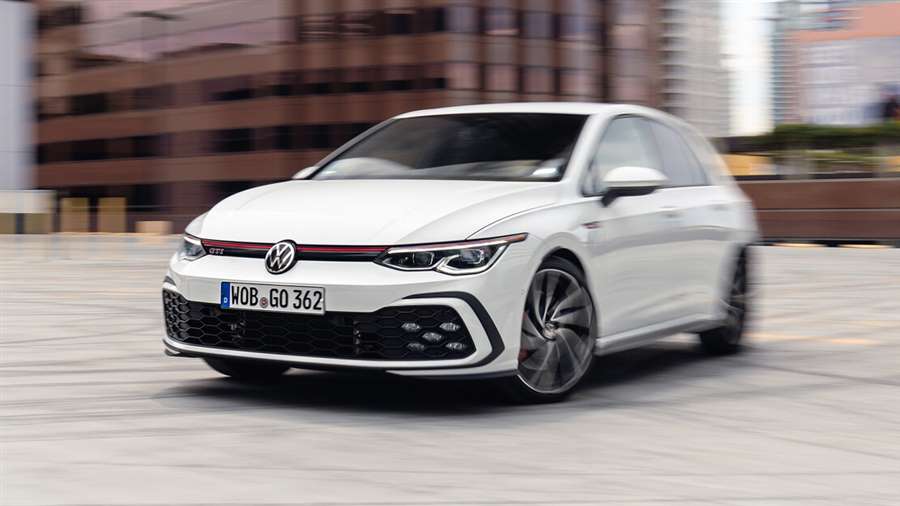
It's enough to make anyone a bit nuts. Though, from behind the wheel of the latest and greatest iteration of the perennial hot hatch gold standard, we might be a bit off with our silly anthropomorphism of the MkVIII. Scooting around traffic-clogged city streets, cramming gear into the cargo area, stuffing friends in the back seat, squeezing into tight parking spaces—it's all handled with the familiar chilled-out, cooler-than-you German modernism that makes the Golf—oops, Freudian slip—GTI such a fan favorite.
Oh, and it's also a hoot and a half to drive, but we'll get to that in a bit. The circumstance surrounding our first scoop of the MkVIII is a bit of a whirlwind; we'd not yet gotten so much as a physical walkaround of the new GTI before it buzzed to our test track to be put through our data-driven trials. So, consider this our first touch, first sniff, first drive, first test—first everything.
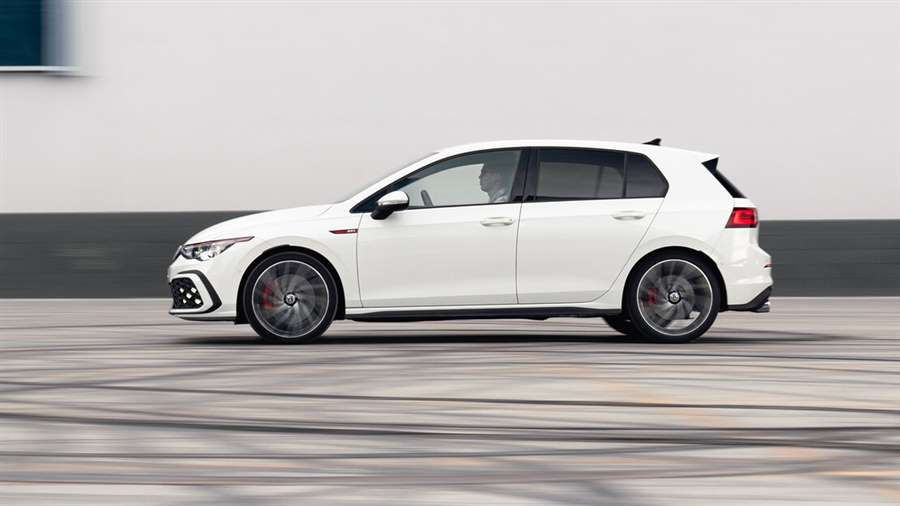
Same As It Ever Was? Hardly.
Still, in a way, this is a meeting of old friends. Underneath those fresh, ID3-esque exterior duds lie the augmented bones of the existing MkVII GTI. VeeDub's rather excellent and wide-ranging MQB platform is still here, so that means if you like how the MkVII GTI rides and drives—boy, you're going to love this.
The 2022 GTI is significantly spruced-up over the existing car. The MacPherson-strut front suspension's wishbone bushings, bump stops, and springs are revised and tweaked, along with the software associated with the optional adjustable dampers. All this is carried by an aluminum subframe that shaves 6.6 pounds over the old setup. It was purloined from the prior GTI Clubsport S, a scorching hot hatch that was briefly the FWD record-holder around the 'Ring.
Around back, the multilink rear suspension is refreshed, too. More software updates and reworked springs, helper springs, wheel mounts, damper bearings, and wishbone bushings keep it all in line. A note on those aforementioned spring rates; they're five percent stiffer in the front and 15 percent stiffer in the rear.
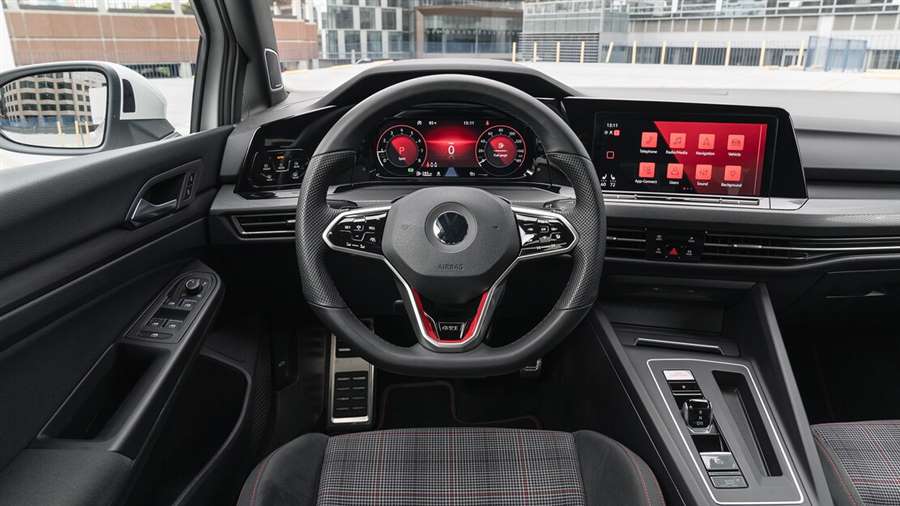
Elsewhere, the software for the electric-assisted steering has been re-coded for sharper turn-in when you want it and lighter effort when you don't. A new brake master cylinder modulates pressure based on driving style and environment: softer and more progressive around town in Comfort mode and a stiff, early bite when you're caning it.
Power, And Lots Of It
Power still comes from the EA888 2.0-liter turbocharged inline-4, but that is the last thing we'd want changed from the MkVII GTI. The Volkswagen Group's ubiquitous turbo-four has, for some of us, become the definitive engine that springs to mind when the subject turns to 2.0Ts. Power is a stout 242 horsepower and 273 lb-ft of torque, routed solely to the front wheels—as the GTI gods intended—through either a six-speed manual or a seven-speed dual-clutch DSG transmission, as in our test car. Crucially, a limited-slip diff is standard, so all MkVIII GTIs should fundamentally be created equal on the performance front.
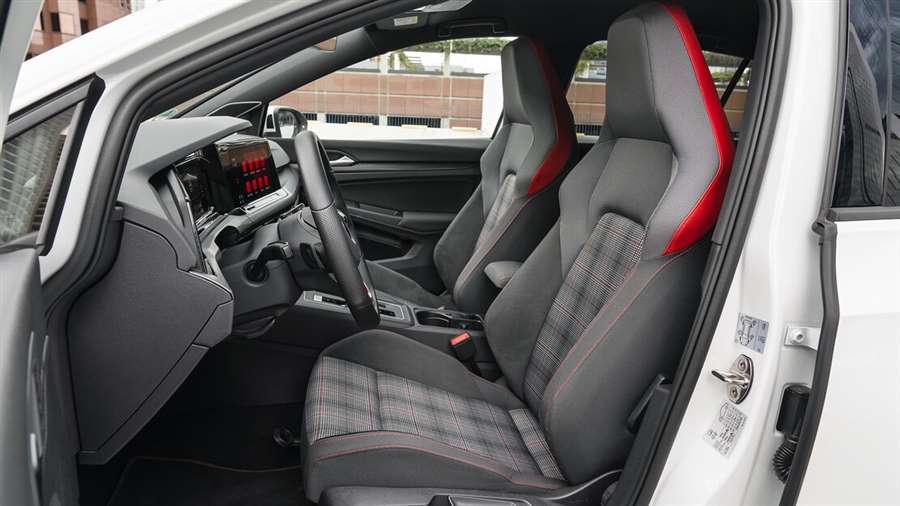
VW says all this adds up to a 0-60-mph run in 6.3 seconds, but we say VW's been taking pages from Porsche's playbook on purposeful underrating. On our strip, associate road test editor Erick Ayapana ran this automatic-transmission front-driver to a very impressive 5.4-second 0-60 time on its way to a 13.9-second quarter-mile, beating out a DSG-equipped MkVII by 0.6 second in both metrics.
The GTI's software didn't make it easy, though. Ayapana had to work around the big torque and tricky transmission tuning in the pursuit of a clean launch. "It's got sloppy launch control," he said. "It holds the engine revs super high and then rides the clutch for what seems like eternity, and after all that, it still couldn't manage wheelspin."
Heroic Handling Habits
Over on the figure-eight and skidpad, the GTI continued its boot-scootin'. It dispatched the ever-tricky figure-eight in 25.0 seconds at an average of 0.74 g, improving on the MkVII GTI with DSG by 1.1 second and 0.05 g. The new GTI hustled around the skidpad at a sweet 0.96 g average, topping its predecessor by a not-insubstantial 0.05 g. This is still notably behind the 24.1-second, 0.81-g average figure-eight time of the latest Honda Civic Type R, but that's fine; the Type R squares off against VW's own Golf R that's coming sometime later this year or early next year.
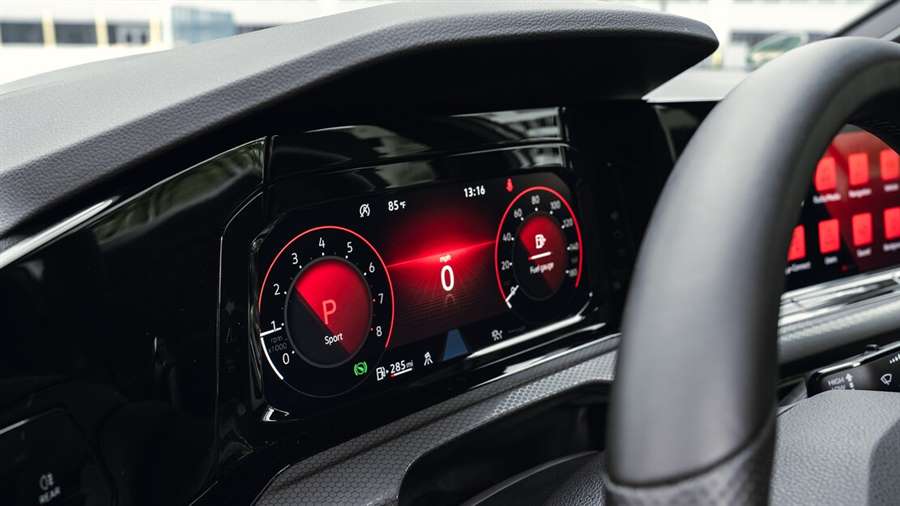
Back on the GTI, road test editor and handling head honcho Chris Walton was duly impressed. "Wow, Volkswagen has really stepped up its game," he said. "The steering is very good; it doesn't feel artificially heavy or light. Just right. I wasn't expecting the GTI to be this capable and fun." Still, like Ayapana, he noted the DSG as having sometimes smart, sometimes baffling programming. Both agreed on the GTI's excellent brakes, which returned a best 60-0-mph stopping distance of 104 feet. "Very confident and talkative brakes," Walton said. "Short travel and you can trail them deep into the skidpad."
Less Track, More Road
The track results are good, but how the new GTI fares on the road—both straight and curvy—is of far greater import. With keys in hand, we couldn't help ourselves—we went straight to the canyons. First impression is that of blissful neutrality; that standard LSD and extensive front-end fettling purged most of the nasty understeer that in the MkVII was always present on the fringes of a too-hot corner entry. Barrel into a corner in the new GTI, and you'll get some tug and scramble from the front end as all the systems frantically but effectively rein in your silliness and shoot you out the other side with nary a scratch.
As it has been for decades, the GTI's is an elemental driving experience, much like a Mazda Miata, Ford Mustang, or Porsche 911. This VW leans into the front-wheel-drive layout, with the most effective method of quick cornering being to feed in throttle just as you approach the apex and allow the front tires and LSD to pull you through like a slingshot. Suspension tuning is predictable and, in the stiffer Sport setting, requisitely flat and composed even during moments of aggressive weight transfer.
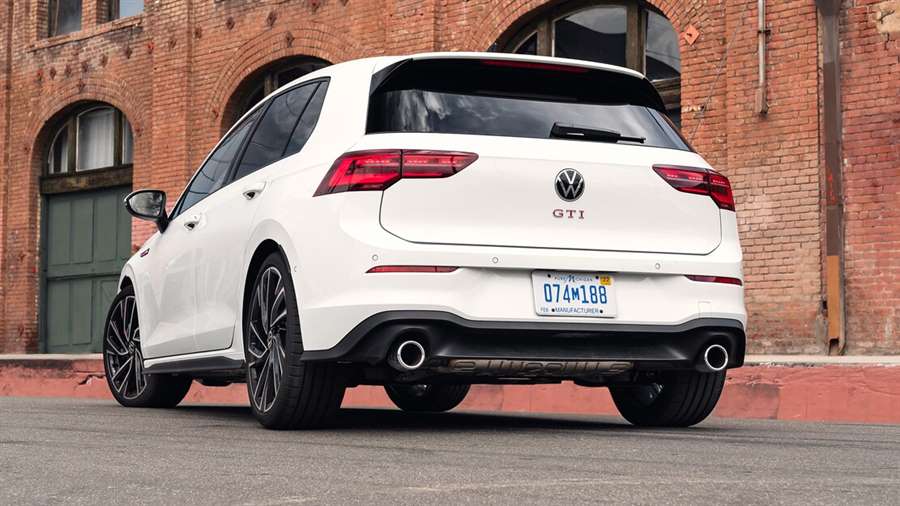
Beautiful Brake Balance
The steering is on the artificial end of the spectrum, but it loads up nicely and is sweetly accurate in the heavier Sport mode. The test team wasn't kidding about the brakes; they're no carbon-ceramic stompers, but these are some of the most confident hot hatch brakes we've experienced in some time. On much of our road drive, we left both the stability and traction control on, fully expecting the brake-actuated systems to sap brake efficacy after a few blasts through our test loop.
Not so. Through a combination of well-tuned TC/ESC and that new variable brake master cylinder, we had to drive absurdly fast on seriously tight roads before the brakes conveyed any sense of softness or fade. Even after extended bouts of hooliganism, the brakes continued to stop strong and true at every corner.
Two-Faced In The Best Way
Power is plentiful, but in torque we trust. Merging and hard pulls down straights were pure fun, with plenty of initial telltale rumble and wheel hop shake up front as the chassis struggled to manage all 273 lb-ft. When it hooks up, you're off, reaching speed and acceleration far beyond the expectations levied by the "GTI" badge on the rear liftgate.
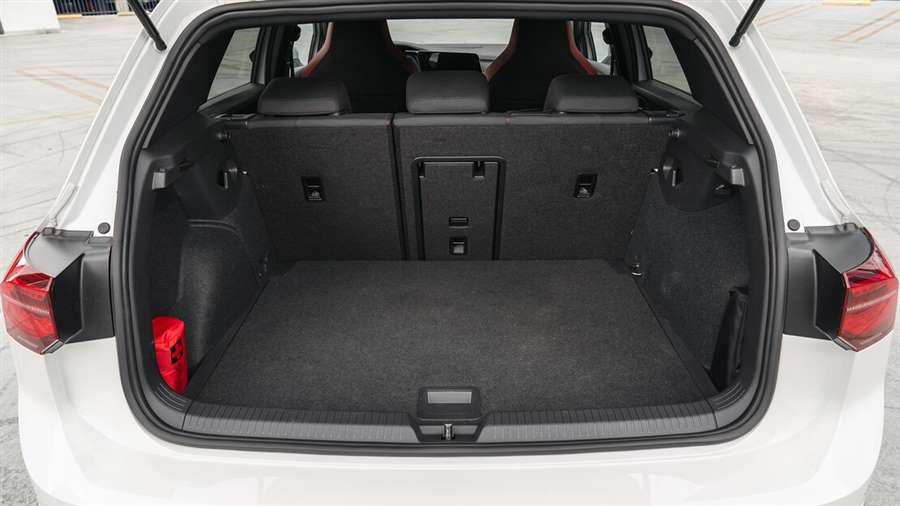
Time to settle down and go home. Back in Comfort mode, everything relaxes and decompresses, transforming a riotous sport compact into a regular hatchback with a vaguely firm suspension. On the oft-broken pavement that snakes through Los Angeles, every bump, crag, and expansion joint was both physically and acoustically well isolated, especially when you futz with the Dynamic Chassis Control's (DCC) 15-position slider to dial in your preferred level of aggression.
Who Asked For This?
Now we get to our singular glaring issue with the all-new VW GTI. It seems VW is keen on superimposing the all-electric ID4's interior tech onto its other new products, meaning the GTI's interior is almost entirely devoid of physical buttons. Instead, touch-capacitive panels adorn the dash and steering wheel, operating just about every function available. The headlights, climate control, drive modes, volume, tuning, cruise control, and cluster menu selection are all operated via these single-piece, backlit gloss plastic panels.
What's not touch capacitive is squirreled away in the sharp and pretty touchscreen infotainment system, but some items seem almost purposefully obfuscated. The traction control, for instance, is buried behind the vehicle settings menu under the "brakes" subsection. It's all very cutting edge and futuristic, but it feels very much like the solution to a problem that didn't exist. We got used to the touch controls within a few hours of seat time, but they never became second nature. What's more, most of the once-glossy surfaces became a modern art installation of greasy fingerprints and nasty smudges. Buttons, please.
Pricing—What We (Don't) Know
What we cannot report on is just how well equipped (or not) the new GTI will be when it hits dealers, as our example was a German-market car, skinny Euro registration plate and all, and the equipment levels could notably differ. Heck, we don't even have a clear idea of pricing, but figure it land somewhere around $31,000. For now, if you want to grab one of these, we think the wait will be well worth it. As the U.S.—and Volkswagen—increasingly cuts ties with internal combustion, it's nice to know joyful cars like the 2022 Volkswagen GTI will be with us until the final switch is flipped.
World premiere: The Mercedes EQS is something completely different
The world premiere of the new flagship of the Mercedes-Benz brand was held on April 15. In the years ahead, the EQS model will have the significance that the S-Class had in the years behind us.
It may be able to connect with important Mercedes only because it is luxurious, but the new top limousine from Stuttgart is different in everything else. The unexpected design, called the "one bow roofline", has made the EQS the most aerodynamic production car in the world.
There is also a giant hyper-screen in the cabin of 141 cm and a range of 700 km on electricity (and the same amount of horsepower in the strongest version). These are just some of the trump cards, in fact, not trump cards, but tasks for others, because we know that, whether people like it or not, history records that Mercedes regularly sets standards. Meet the EQS - the electric sedan of the future, in the present.
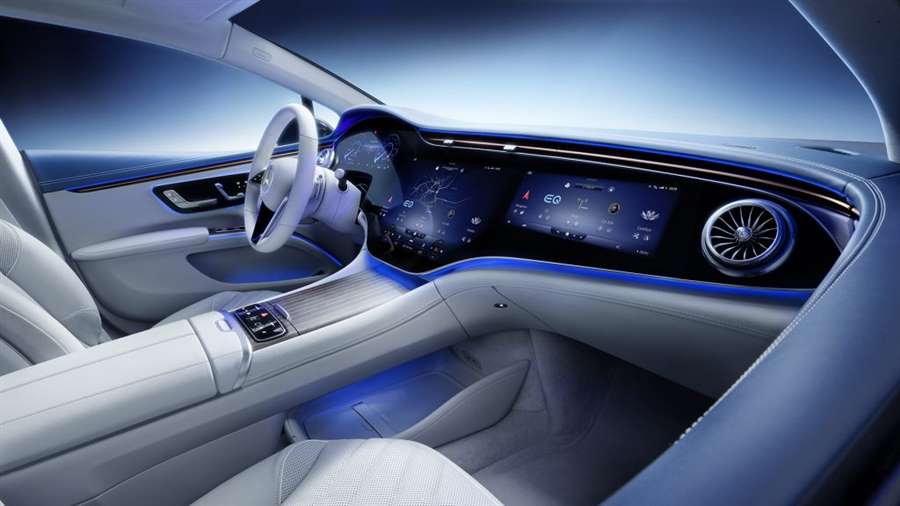
The design of the arch-like sedan, which may not appeal to everyone, has contributed to the 0.20 cd EQS being, as we said, the most aerodynamic production electric sedan (better than both the Tesla S and the Lucid Air model). It's even a kind of legacy from Mercedes - some of the most cult models from the past could also boast that the gusts of wind can be their allies. We are thinking of one of the models that always evokes fond memories, and it was also the first compact sedan with a star on the hood - the legendary 190.
So, design. Yes, it is unusual. Some are already saying that the profile is "critical", while the EQS from the front and back is great. But it's still too fresh to comment. The design should be given time to settle, which has been confirmed many times throughout history. What we can say is that we liked the electric rival from Audi - the e-tron GT, at first glance. But we whispered that to you. We said we wouldn’t talk about design, much less about tastes.
EQS is the so-called "Liftback" sedan which, as they say from Mercedes, should cost something similar to the new S-Class. We'll see.
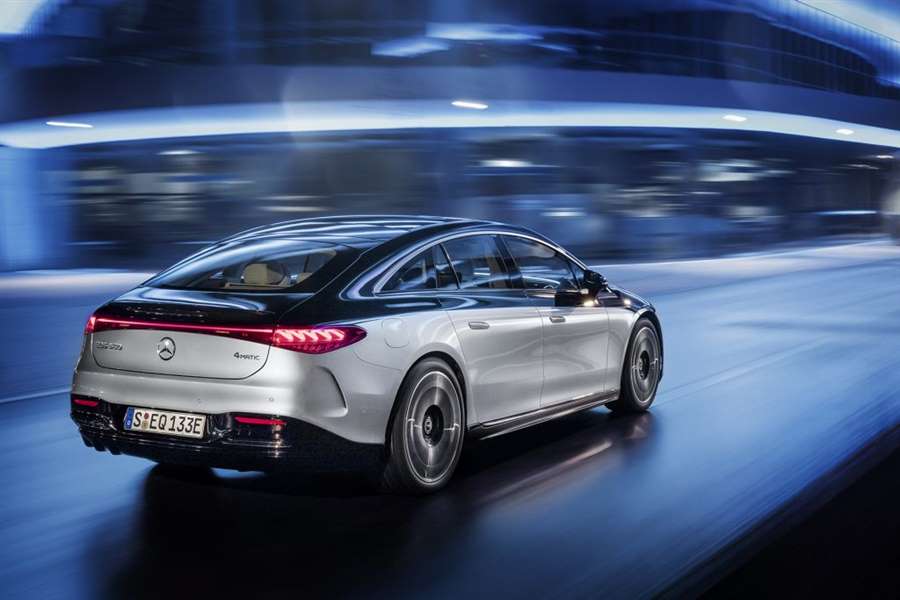
This sedan is also the first Mercedes to be built from scratch as an electric vehicle. It was created on the EVA platform on which EQE (E-Class on electricity), then EQE SUV, as well as EQS SUV will be based.
This base, among other things, allows them special air suspension and control of the rear wheels. Thus, the EQS is 5.2 meters long, 1.9 m wide and 1.5 m high, in addition to being aerodynamic, it also boasts a turning diameter of only 10.9 meters.
The distance between the axles is 3.2 meters (106 cm more than the S-Class), which means that two-meter walkers will be able to stretch their legs inside without any trouble. The lucky ones. And they will also enjoy the "No.6 Mood Linen" fragrance designed especially for EQS. It is number 6 because the first electric cars were added to the 1906 model range with "Mercédès Electrique" vehicles.
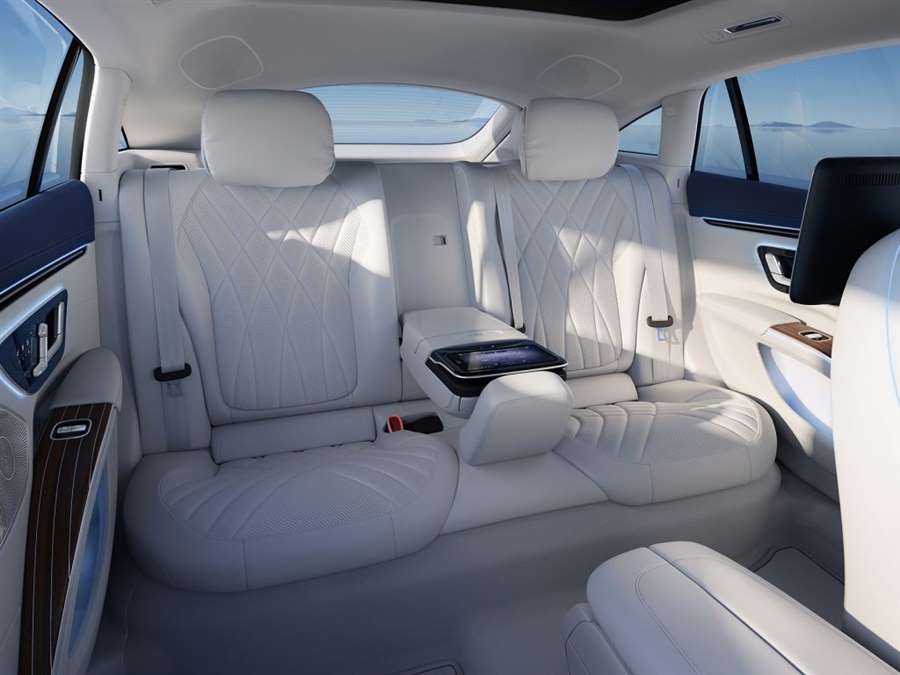
Who cares, the trunk is 610 / 1,770 liters (60 liters more than the S-Class).
Design. Again. It is important to say that the EQS is also made of a lot of aluminum, and in front of the mask there is a black panel that connects the headlights connected by a light strip that extends the entire width of the front part. Now watch this - Digital Light has a light module with three extremely powerful LEDs with light that is refracted and directed by 1.3 million micro mirrors. The resolution is, therefore, greater than 2.6 million pixels per vehicle. That's what they say in Mercedes.
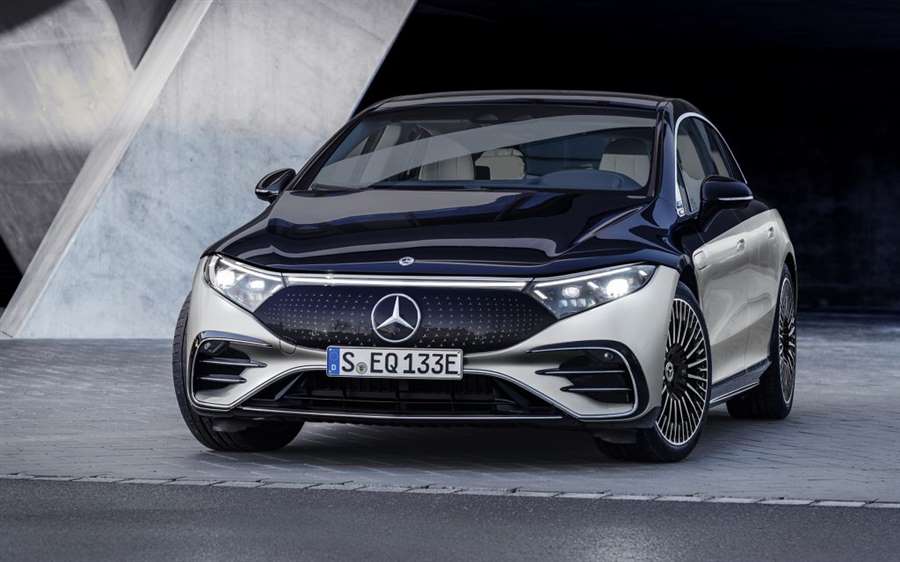
What's inside
We have already written about the cabin, because it was shown before the premiere (find out more here), so we will now present some very interesting figures and information about the hyper-madness inside. With the MBUX Hyperscreen, several screens seem to blend seamlessly, resulting in an impressive curved screen width of 141 centimeters.
The large glass covered by the Hyperscreen is three-dimensionally curved in the molding process at temperatures of approximately 650 ° C. This manufacturing process allows the display to be displayed without distortion across the entire width of the vehicle.
To get to the most important MBUX applications, the user navigates through 0 menu levels. Everything is there right away. That is why it is called "zero layer". Also, through this system, the driver has the option of remotely opening the rear door.
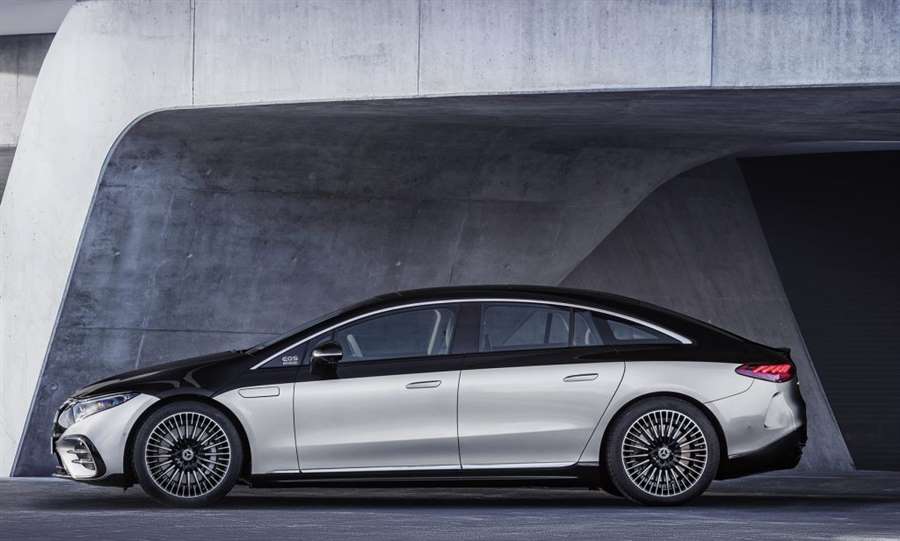
The display area of the optional larger head-up display corresponds to a 77-inch screen. The projection unit consists of a high-resolution matrix of 1.3 million individual mirrors. And they say that in a Mercedes.
For haptic feedback during operation, a total of 12 actuators are located below the surfaces of the Hyperscreen. If the finger touches certain places, they trigger vibrations. The coating on the glass makes cleaning easier, and only the curved glass consists of scratch-resistant aluminum silicate.
Two versions of EQS
The rear axle of the EQS 450 has an electric motor that delivers 333 hp and 568 Nm, while the more powerful EQS 580 has two electric motors (on each axle), thus offering e-4 × 4 drive and a total power of 523 hp and 885 Nm.
It reaches the "hundredth" EQS, weighing 2.5 tons, in 4.3 seconds, or 6.2 in the weaker version. Top speed is 210 km / h. Both versions use a powerful 107.8 kWh battery that can provide a range of 700 km.
An AMG variant is planned to be based on the EQS 580 iwill have more than 700 hp.
Otherwise, depending on the equipment, up to 350 sensors monitor the functions of the EQS and explore the vehicle's environment. And we don't count antennas in that number. The sensors measure, for example, distance, speed and acceleration, lighting conditions, precipitation and temperature, seat occupancy, and count and monitor the movement of the driver's hood or passenger speech.
So much for advanced technology for today.
You’ll never guess what the Chevrolet Camaro is having trouble with
No… It's not a click-bait title, but this short story is so shifted at its core that it was not clear to me who was still in "Aprilililili mode".
Basically, here are short stories about this American nebula…
At the beginning of this and still current in 2021, Chevrolet went public with a somewhat strange announcement.
And on that occasion it was said that "Due to restrictions in California and Washington relating to copper brake pads, customers in those states cannot order Camaro SS, ZL1 and 1LE for delivery after January 1, 2021."
All of this was nicely and concretely stated and signed by Mr. Kevin M. Kelly as Senior Communications Manager at General Motors.
And the reason for this beautiful announcement comes down to one of the most silly studies and assumptions that have ever emerged in the world of cars. Because according to some research conducted within these two states, the Chevrolet Camaro in its SS, ZL and 1LE derivatives releases copper into the atmosphere from its brake pads. And then that copper can come in contact with water surfaces and bother salmon.
Yes… You read that right: Camaro are not sold in California and Washington because of salmon.
Because of faking salmon!
The explanation of this theory states that by wearing brake pads, copper is released into the atmosphere, and some of these particles end up in waterways. So as copper itself is toxic to salmon, it has prompted lawmakers to limit the use of copper in brake pads. Or to simply stop offering models that have copper as a component in their brake pads. That is, models whose brake pads have more than 5% copper within the total ratio of the materials of which they are made.
So as the Chevrolet Camaro in its derivatives uses copper as a component of which the brake pads are composed, so the Camaro in question from 1 January 2021 may not be sold in these two above-mentioned countries.
But that's not all.
Because they are Americans after all, so more dramaturgy is needed for this story…
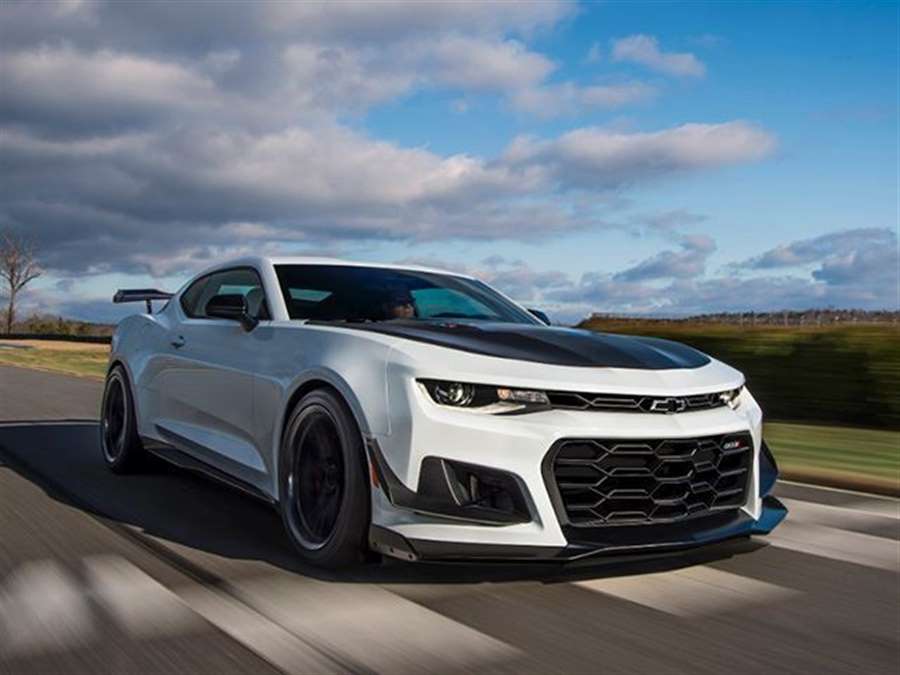
Namely, with the exception of copper present in the brake pads, it is badly considered and the abolition of certain types of tires is also not in line with waterways and salmon that swim on them. Because some of the tires use the antioxidant designation 6PPD-Quinone. And that bad antioxidant is responsible for the streams and rivers where it ends up during tire wear on a paved surface.
So now I'm just waiting to see the list of manufacturers and models of tires that kill salmon with their particles. And then I go to support the murder of a few more and buy a can containing at least part of it. Because it is as meaningless a reaction to this kind of news as the news itself is the meaninglessness of today's life on the road.
And it is only a matter of time before eco-mentalists in our region will realize that, for example, driving a Golf "deuce" poses a danger to the development of pulmonary alveoli on salamanders. Or that buying cheaper winter tires negatively affects the sex life of earthworms.
And then we are again followed by bans, regulations and penalties which, like the last jerks, will fill the state budget.
Wonderful, isn't it ?!

